In the vibrant realm of fashion, the question of where fashion designers work is as varied as the designs they create. The fashion industry is abundant with diverse locations that influence the career paths available to today’s designers. From prestigious high-end ateliers in renowned fashion capitals to contemporary corporate environments and the increasing trend of freelancing, the job opportunities for fashion designers continue to evolve.
As the landscape shifts, understanding these fashion industry locations becomes crucial for aspiring creative talents. Designers can find themselves shaping trends within bustling cities or exploring exciting emerging markets, underscoring the significance of location in navigating their careers. This journey into the diverse world of fashion workplaces reveals not only the dynamics of design but also the profound impact geographical context can have on the success and visibility of a designer.
Fashion Industry Locations
The global fabric of the fashion industry is intricately woven through various locations that serve as epicentres for creativity, innovation, and commerce. Understanding these pivotal fashion industry locations reveals much about the dynamics of style and market trends. The influence of major fashion capitals like Paris, Milan, London, and New York cannot be understated. Each city brings its unique cultural identity, economic resources, and creative talent, shaping global fashion narratives.
Major Fashion Capitals
In each of the major fashion capitals, the environment teems with inspiration and opportunity:
- Paris: Renowned for its elegance, Paris is home to legendary fashion houses like Chanel and Dior, making it a leader in haute couture.
- Milan: The epicentre of Italian fashion, Milan boasts names such as Gucci and Prada, emphasising craftsmanship and innovation.
- London: Known for its eclectic styles, London promotes a blend of traditions and contemporary designs, fostering emerging talent.
- New York: A melting pot of cultures, New York drives trends with a diverse fashion landscape and institutions like FIT nurturing new generations of designers.
Emerging Markets in Fashion
As the industry evolves, so do the emerging markets in fashion. Locations such as Shanghai and Lagos are gaining prominence:
- Shanghai: With rapid economic growth and a burgeoning middle class, Shanghai is increasingly becoming a critical player in global fashion.
- Lagos: The creative scene in Lagos is vibrant, showcasing local designers who are making their mark on a global scale with unique narratives.
These regions highlight shifting dynamics in the fashion world, presenting opportunities for designers eager to explore new horizons. With robust growth trends, the potential of these emerging markets signifies exciting possibilities within the global fashion landscape.

Where Do Fashion Designers Work
The world of fashion design offers a variety of environments where creativity flourishes. Each setting presents unique opportunities for designers to showcase their talents. Fashion designer job locations encompass both established institutions and independent ventures, allowing artists to choose the path that best suits their style and aspirations.
High-End Ateliers
High-end ateliers stand as the epitome of luxury within the fashion designing profession settings. These exclusive spaces provide a canvas for bespoke creations, where artisans meticulously craft garments tailored to individual clients. Renowned establishments like Chanel and Dior exemplify the artistry and attention to detail that characterise these environments. Designers here often collaborate closely with skilled seamstresses and artisans, resulting in masterpieces that reflect personal vision and craftsmanship.
Corporate Fashion Brands
Working in corporate fashion brands offers a different experience, focusing on the mass production of garments. Designers within companies such as Zara and H&M operate in structured teams, streamlining the process to meet the demands of the fast-paced retail market. This environment fosters creativity while adhering to brand guidelines and commercial viability. The collaboration within these larger frameworks can lead to significant exposure and professional growth.
Freelancing Opportunities
Freelancing opportunities are increasingly popular among modern fashion designers seeking flexibility and creative freedom. This approach allows individuals to select projects that resonate with their artistic identity. By working independently, designers can forge their paths, collaborate with different clients, and even explore various niches within fashion, such as costume design or sustainable fashion. While this path offers distinct advantages, it also requires self-discipline and a keen understanding of market trends.
Career Paths in Fashion Design
The world of fashion design offers a plethora of career paths that attract individuals with various talents and passions. Aspiring designers can explore different specialisation areas to tailor their careers according to personal interests and market trends. Each specialisation provides unique employment options for fashion designers, from high-end design to innovative sustainable practices.
Specialisation Areas
Choosing a specialisation area is crucial in defining a successful career in fashion design. Areas like haute couture focus on meticulously crafted garments, often showcased in exclusive fashion shows. Ready-to-wear lines offer more accessible options, bridging high fashion and everyday wear. Additionally, there is a growing interest in sustainable fashion, which emphasises eco-friendly materials and practices. A well-defined specialisation can lead to a more fulfilling career, aligning one’s creative vision with consumer demand.
Advancement Opportunities
As designers grow in their careers, numerous advancement opportunities become available. Gaining experience can lead to leadership roles within established firms or the chance to launch personal labels. Networking plays a pivotal role in this growth, allowing designers to connect with industry professionals and collaborators. Continuous education through workshops and courses further enhances skills, keeping designers competitive in a dynamic market.
Clothing Design Workplaces
The world of clothing design encompasses a variety of specialised environments that play a crucial role in creating fashion. Understanding these clothing design workplaces reveals the intricate intersections between creativity and production, highlighting the journey from concept to retail.
Manufacturing Facilities
Manufacturing facilities are the backbone of fashion production. Here, raw materials are transformed into finished garments through a blend of skilled craftsmanship and advanced technology. Designers collaborate closely with technical teams to ensure that their visions come to life. These facilities often utilise innovative machinery and sustainable practices, reflecting the industry’s shift towards sustainability and efficiency. With an emphasis on quality control, manufacturing facilities ensure that every item meets brand standards before reaching the consumer.
Showrooms and Retail Environments
Showrooms and retail environments serve as vital platforms for designers to showcase their work. These spaces allow for direct interaction with buyers, clients, and the public, offering a unique opportunity to present collections in a curated setting. Designers strategically craft their displays to highlight the essence of their brand, creating a sensory experience that engages potential customers. Retail environments, in particular, are where the final pieces find their audience, bridging the gap between the creative process and market demand.
Popular Work Environments for Fashion Designers
Fashion designers often explore diverse environments where they can showcase their talents and creativity. Engaging in various sectors expands their influence and allows them to leave a lasting mark on the industry.
Fashion Magazines and Editorials
Fashion magazines serve as prominent platforms for designers to present their creations. Renowned publications such as Vogue and Harper’s Bazaar not only feature their work but also shape public perception of style and trends. Working with fashion magazines allows designers to connect with a wider audience, building their brand in the competitive landscape of fashion.
Collaboration with Artists
Collaboration with artists offers an exciting avenue for innovation. By partnering with painters, sculptors, or graphic designers, fashion designers can infuse their collections with unique perspectives and fresh ideas. Such collaborations often result in memorable pieces that bridge the gap between fashion and fine art, enriching both disciplines.
Event and Costume Design
Another significant aspect of fashion design lies in event and costume design. Designers contribute significantly to theatrical productions, films, and high-profile events, crafting garments that enhance storytelling and character development. These opportunities provide a dynamic working environment, showcasing the versatility of designers as they adapt their skills to the performing arts.
Employment Options for Fashion Designers
Fashion designers are presented with a diverse array of employment options that continue to evolve within a rapidly changing landscape. Traditional roles in established fashion houses, such as designer positions at renowned brands like Burberry or Alexander McQueen, remain popular. However, the rise of technology has opened up a new realm of job opportunities for fashion designers, with digital platforms now playing a crucial role in how fashion is created, marketed, and sold.
Freelancing has also gained traction, as many designers seek to establish their own identities through independent projects or collaborations. This shift towards a more flexible work environment not only enhances job security but also allows for creative freedom that is paramount in this industry. Additionally, global events have significantly influenced employment trends, pushing the focus towards sustainability and ethical practices within fashion, presenting further avenues for designers committed to making a positive impact.
As we look to the future, it is clear that the evolving expectations within the fashion industry will continue to shape employment options for fashion designers. Embracing innovation while remaining dedicated to ethical design principles will be essential for those seeking to thrive in this competitive field. The ability to adapt to new technologies, sustainability practices, and emerging market trends ensures that job opportunities for fashion designers will remain robust and dynamic.









